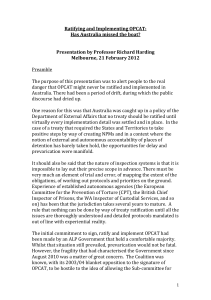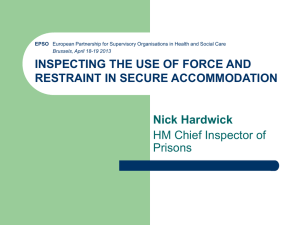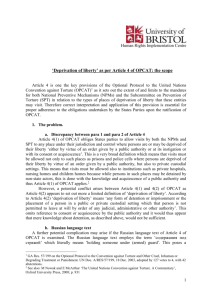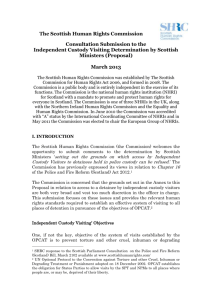The Optional Protocol to the UN Convention against Torture
advertisement
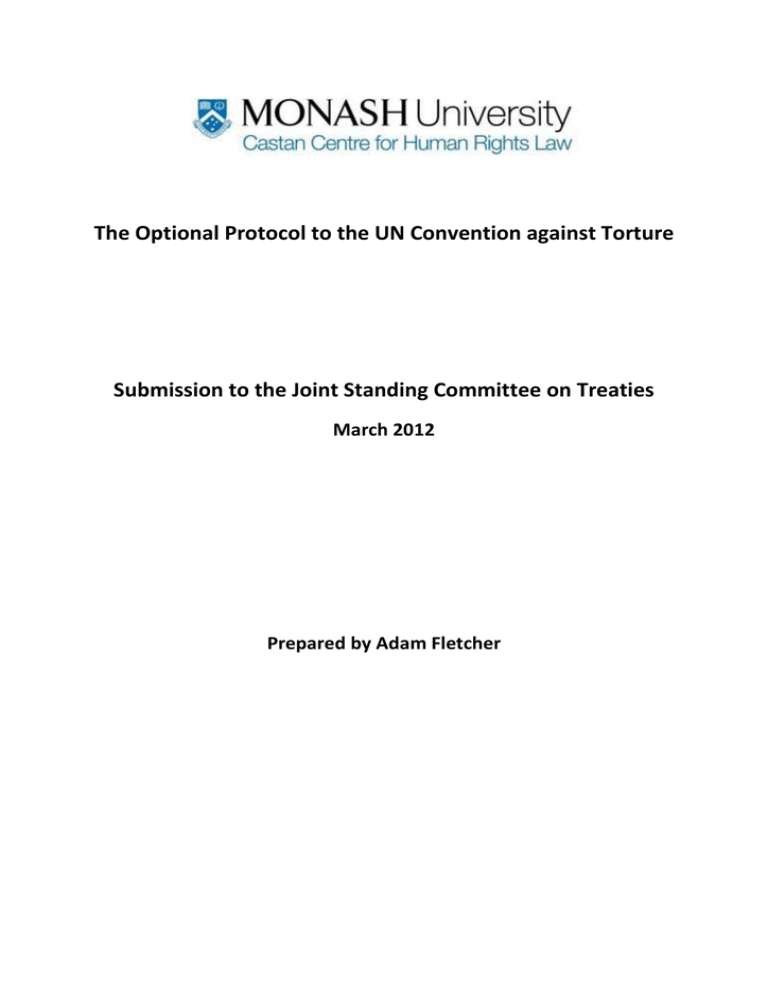
The Optional Protocol to the UN Convention against Torture Submission to the Joint Standing Committee on Treaties March 2012 Prepared by Adam Fletcher Introduction The Castan Centre thanks the Committee for the opportunity to comment on Australia’s proposed ratification of the Optional Protocol to the Convention against Torture (OPCAT). The Centre welcomes the Government’s National Interest Analysis (NIA) of the OPCAT,1 which was tabled in Parliament on 28 February 2012. As stated in our submission to the Attorney-General’s Department in its consultations on the NIA,2 as well as the open letter to Attorney-General Roxon of 21 December 2011 which we co-signed,3 the Centre strongly supports Australian ratification of the OPCAT. We urge the Committee to overturn the finding of its predecessor from the 40th Parliament,4 and recommend Australia become a party to this treaty without further delay. Why Australia needs to ratify the OPCAT The reasons for Australia to become a party to the OPCAT are clear and compelling: 1. The OPCAT is designed to improve conditions for, and treatment of, those deprived of their liberty. Australia can do better on both counts, as outlined below. 2. Transparency and accountability are essential where the State has complete control over people’s lives, and presently Australia’s places of detention (broadly defined in the OPCAT5) lack a consistent, coordinated system to ensure transparency and accountability. 3. Ratification of the OPCAT (in the good company of an increasing number of like-minded countries – 62 at the time of writing6) would reinforce the Australian Government’s commitment to tackling cruel, inhuman and degrading treatment (‘ill-treatment’), which it demonstrated in 2010 with the enactment of a specific offence of torture.7 4. The cost of prevention by means of regular monitoring is outweighed by the potential negative impacts of ill-treatment to our society and our international reputation. This submission addresses each of these reasons in turn. 1 [2012] ATNIA 6. <http://www.law.monash.edu.au/castancentre/publications/op-cat-sub.pdf>. 3 <http://www.piac.asn.au/sites/default/files/news/attachments/letter_to_ag_re_opcat_0.pdf>. 4 See: JSCOT, Report 58, tabled 23 March 2004, which found that ratification of the OPCAT was unnecessary. 5 See OPCAT, article 4. 6 See: <http://www.apt.ch/opcat>. 7 By means of the Crimes Legislation Amendment (Torture Prohibition and Death Penalty Abolition) Act 2010. 2 Australia can do better when it comes to treatment of people deprived of their liberty Examples of ill-treatment of those deprived of their liberty are unfortunately not difficult to find in Australia. In recent years, reports from organisations which have visited places of detention have revealed treatment and conditions which fall short of international standards (and may even fall foul of international prohibitions). These include reports from the Western Australian Inspector of Custodial Services,8 the Victorian Ombudsman,9 the Australian Human Rights Commission (AHRC)10 and Amnesty International11 Examples include WA’s Roebourne Regional Prison, which was found to be overcrowded, rat-infested and ill-protected from the desert heat;12 the Melbourne Youth Justice Precinct, which was found to be so crowded that the juvenile detainees had to go to the toilet in buckets;13 the death of a detainee in NSW due to inadequate facilities/procedures for the mentally ill;14 the lack of basic sanitary facilities and privacy in ACT remand centres,15 and several high-profile deaths in police custody, including a man who died due to extreme heat exposure during prisoner transport in WA.16 If we broaden our view to immigration detention centres, the evidence of ill-treatment is even more overwhelming. The rate of mental illness caused by both the conditions and the indefinite nature of detention in these centres has been well documented and, in some 8 See eg: ‘Report of an Announced Inspection of Roebourne Regional Prison,’ 2011: <http://www.custodialinspector.wa.gov.au/go/reports-and-reviews>. 9 G. E. Brouwer, Ombudsman of Victoria, ‘Whistleblowers Protection Act 2001: Investigation into conditions at the Melbourne Youth Justice Precinct’ (October 2010). 10 See eg: ‘Immigration Detention on Christmas Island’ (Australian Human Rights Commission 2010): <http://www.hreoc.gov.au/human_rights/immigration/idc2010_christmas_island.html>. 11 ‘An Uncertain Future: Inside Australia’s Detention Centres’ (Amnesty International 2010): <http://www.amnesty.org.au/refugees/comments/24020> and ‘What we found behind the fences’ (Amnesty, 2012) <http://www.amnesty.org.au/refugees/comments/27966>. 12 See above n 8, also ‘Inspection slams WA prisons,’ WA Today, 6 April 2011: <http://www.watoday.com.au/wa-news/inspection-slams-wa-prisons-20110406-1d4lz.html>. 13 See above n 9. 14 See ‘Inquest into the Death of Scott Ashley Simpson,’ NSW Deputy State Coroner, 2006: <http://www.lawlink.nsw.gov.au/lawlink/Coroners_Court/ll_coroners.nsf/vwFiles/SimpsonInquest.doc/$file/Si mpsonInquest.doc>; see also AHRC submissions to Coroner, which outline breaches of human rights involved in the case: <http://www.hreoc.gov.au/legal/submissions_court/intervention/simpson.html>. 15 See Human Rights Audit on the Operation of ACT Correctional Facilities under Corrections Legislation, ACT Human Rights Commission, July 2007: <http://www.hrc.act.gov.au/res/Corrections Audit 2007.pdf>. 16 See ‘Government pleads guilty in Mr Ward death,’ WA Today, 5 May 2011: <http://www.watoday.com.au/wa-news/government-pleads-guilty-in-mr-ward-death-20110505-1e9s3.html>; see also eg The Use of Taser Weapons by WA Police, WA Corruption and Crime Commission, October 2010: <http://www.ccc.wa.gov.au/Publications/Reports/Published%20Reports%202010/Full%20Report%20%20Use%20of%20Taser%20Weapons%20by%20WAPOL.pdf>; ‘Finding of Inquest into the Death of Mulrunji,’ Queensland Coroner’s Court 2006: <http://www.courts.qld.gov.au/mulrunji270906.pdf>; also eg Michael Reed ‘Man Who Died Inside Melbourne Assessment Prison was Unconscious for Almost 1 Hour, Left Untreated’, The Courier Pigeon, (1 December 2010): <http://thecourierpigeon.com.au/man-who-died-inside-melbourneassessment-prison-was-unconscious-for-almost-1-hour-left-untreated/85315>. tragic cases, has led to self-harm and suicides.17 The Committee would be well aware of criticism of Australia’s immigration detention facilities from Australian and international human rights organisations,18 and even the United Nations.19 Recent reforms20 notwithstanding, Australia’s treatment in detention of asylum-seekers who arrive by boat has done a great deal of damage to our international reputation, and opening up these centres to rigorous OPCAT-based oversight would go a long way towards rebuilding our international standing. Another pressing detention issue in Australia today is the over-representation and ill-treatment of Indigenous people in custody,21 and the inadequate response to the seminal Report of the Royal Commission into Aboriginal Deaths in Custody of 1991.22 Last year was the 20th anniversary of the Report, and recent updates show little progress has been made in this area.23 Implementation of a National Preventive Mechanism under the OPCAT might not be able to address the over-representation issue, but it certainly has the potential to address many of the recommendations of coronial reports into deaths in custody which have identified policy vacuums, procedural failings and incompetence and neglect on the part of custodial and health authorities.24 The OPCAT’s primary purpose is to lift standards in detention through a dialogue between inspectors and the relevant authorities. Such dialogue may breach the impasses on the issue of conditions of detention for both asylum-seekers and Indigenous people, issues which remain unaddressed despite urgent calls for reform over so many years. As the National 17 See eg ‘2011 Immigration detention at Villawood: Summary of observations from visit to immigration detention facilities at Villawood’ AHRC 2011; ‘Time to rethink our mandatory detention system’ (AHRC press release 17 March 2011) and ‘Potential for suicide and self-harm is a real concern’ (AHRC press release 26 May 2011); ‘Mental health facilities labelled “prisons”’, ABC News, 25 March 2011, <http://www.abc.net.au/news/stories/2011/03/25/3174182.htm>; ‘Treatment of Tasmania’s mentally ill criticised,’ ABC News, 23 November 2010 <http://www.abc.net.au/worldtoday/content/2010/s3074051.htm>. 18 See eg ‘Submission to the Joint Select Committee on Australia’s Immigration Detention Network,’ Castan Centre 2011: <http://www.law.monash.edu.au/castancentre/publications/immigration-detentionnetwork.pdf>. 19 See eg Concluding Observations of the UN Committee Against Torture and Other Cruel, Inhuman or Degrading Treatment or Punishment on Australia’s Third Periodic Report under article 19 of the Convention, UN Doc CAT/C/AUS/CO/3 (22 May 2008) [25]; C v Australia (UN Human Rights Committee Communication 900/1999 (Views of 13 November 2002) finding a breach of the author’s right under article 7 of the ICCPR); ‘Human Rights Commissioner Criticises Australia,’ ABC Lateline, 25 May 2011: <http://www.abc.net.au/lateline/content/2011/s3227133.htm>. 20 See ‘New single process for all asylum arrivals,’ The Age, 20 March 2012: <http://www.theage.com.au/opinion/political-news/new-single-process-for-all-asylum-arrivals-201203191vftl.html>. 21 See above n 16. 22 See eg Mathew Lyneham, Jacqueline Joudo Larsen, and Laura Beacroft, ‘Deaths in custody in Australia: National Deaths in Custody Program 2008,’ (Monitoring Report No. 10 of the Australian Institute of Criminology). 23 See <http://www.aic.gov.au/criminal_justice_system/indigenousjustice/cjs/dic.aspx> for links to the original report and a collection of relevant publications. 24 See ‘Why are deaths in custody rising?’ Crikey, 15 April 2011: <http://www.crikey.com.au/2011/04/15/deaths-in-custody-20yrs-after-a-royal-commission-why-are-fatalitiesrising>. Interest Analysis notes, the OPCAT will also “improve outcomes in the detention of people in Australia by providing a more integrated and internationally recognised mechanism for oversight. It will provide an opportunity for organisations involved in detention management and oversight to share information, guidelines, practices and problem solving measures with regard to the conditions and treatment of people in detention.”25 Transparency and accountability are essential Experience around the world has shown that independent oversight of closed environments is key to ensuring human rights violations do not occur.26 The Council of Europe has had a treaty for the prevention of torture in place since 1989.27 Under this treaty, the European Committee for the Prevention of Torture (CPT)28 has a mandate to, “by means of visits, examine the treatment of persons deprived of their liberty with a view to strengthening, if necessary, the protection of such persons from torture and from inhuman or degrading treatment or punishment.”29 It has been very effective in reducing the incidence of torture and other ill-treatment in that jurisdiction.30 In the UK, Her Majesty’s Inspectorate of Prisons for England and Wales31 was established in 1981 as an independent external monitoring body of prisons, and has also had a beneficial effect on the operation of UK correctional institutions.32 While many closed environments – including in Australia – have some form of internal oversight, this is sometimes insufficient to prevent and remedy human rights violations due to conflicts of interest which arise when criticism is warranted.33 Independence is critical to the effectiveness of any oversight mechanism – a fact which is generally recognised in Australia as attested to by the existence of Royal Commissions, Independent Commissions against Corruption and Ombuds Offices (to name a few). In Western Australia, there has 25 Above n 1, [7]. See eg Michele Deitch, ‘Special Populations and the Importance of Prison Oversight’, (2009-2010) 37 American Journal of Criminal Law 291,292 & 295. See further Deitch, ‘Opening up a Closed World: A Sourcebook on Prison Oversight,’ (2010) 30 Pace Law Review 1687. 27 Convention for the Prevention of Torture and Inhuman or Degrading Treatment or Punishment ([1989] ETS 126, entry into force 1 February 1989). 28 <http://www.cpt.coe.int/en/about.htm>. 29 Article 1. 30 See eg Silvia Casale, ‘Mechanisms for Custodial oversight: The United States and Europe’ (2006) 22 Washington University Journal of Law and Policy 217, 224-227 with respect to the CPT and the effect it has had on conditions of those in custody in Europe; see also New partnerships for Torture Prevention in Europe: Proceedings of the Conference, 6 November 2009 <http://www.cpt.coe.int/en/documents/cpt-aptproceedings.pdf>, particularly presentation of Manfred Nowak, then UN Special Rapporteur on Torture (107). 31 Now part of the National Preventive Mechanism under that country’s OPCAT implementation framework – see The way Forward – Joining the International Oversight Regime below. 32 See eg Anne Owers, ‘Submission to Vera Commission’ (paper on the functioning and value of the Inspectorate), (2006) 22 Washington University Journal of Law & Policy 231. 33 This is discussed in eg Silvia Casale, ‘Mechanisms for Custodial oversight: The United States and Europe’ (2006) 22 Washington University Journal of Law & Policy 217, 228. 26 been an independent Inspector of Custodial Services since 1999.34 Despite the success of this office,35 it has not been duplicated in other States and Territories, let alone nationally. As a result, Australia lacks a consistent, comprehensive scheme for the independent oversight of the treatment of people in closed environments.36 Robust independent and external monitoring can have a positive impact through a preventive (as opposed to reactive) approach to human rights violations. A preventive approach has the potential to minimise abuses that can occur in closed environments by maintaining high standards. It is better for all concerned to prevent the abuse from happening in the first place, than merely to provide redress for wrongs that have already been committed. Most current oversight mechanisms in Australia play a primarily remedial role in addressing complaints of human rights violations and do not necessarily take a proactive/preventive approach.37 The Centre acknowledges that the Commonwealth Ombudsman and Australian Human Rights Commission have at times taken a more proactive approach, including initiating inspections and inquiries, particularly in areas of great need, such as immigration detention. However, along with their State and Territory analogues, these bodies generally focus on investigations of breaches of the relevant human rights and/or anti-discrimination legislation, because that is what they were established (and are funded) to do. Moreover, the systems Australia has in place have not necessarily been designed pursuant to international standards, and consequently struggle to live up to Australia’s international human rights obligations.38 Finally, the National Interest Analysis itself states that “there are varying levels of oversight both between different types of detention, and between jurisdictions. There are also some gaps in monitoring – the key area of significance being detention in police detention facilities – which could be addressed by implementing the Optional Protocol.”39 The Way Forward – Joining the International Oversight Regime The international community has called upon Australia to implement greater oversight mechanisms. In its Concluding Observations on its review of Australia in 2008, the UN Committee Against Torture specifically called upon Australia to “ensure the Immigration 34 <http://www.custodialinspector.wa.gov.au>. The office has, for example, worked with the WA Government to improve services for young Aboriginal offenders ( see <http://www.watoday.com.au/wa-news/a-new-class-of-wa-prisoners-20090903-f9vt.html>) and both the WA Coroner and Police Commissioner have endorsed and/or recommended an expansion of the Inspector’s role (see <http://www.watoday.com.au/wa-news/dead-aboriginal-man-onearmed-alcoholic20110110-19koc.html> and <http://deathsincustody.org.au/sites/default/files/Ward_finding.pdf>). 36 Richard Harding and Neil Morgan, ‘Implementing the Optional Protocol to the Convention against Torture: Options for Australia, a report to the Australian Human Rights Commission’ (2008) Ch 4. 37 Ibid, [6.44-6.49]. 38 Ibid, [6.24]. 39 Above n 1, [9]. 35 Detention Standards be codified into legislation and provide for an independent monitoring mechanism” in relation to immigration detention, and to “speedily conclude its internal consultation and ratify the Optional Protocol to the Convention in order to strengthen the prevention against torture.”40 The UN Human Rights Council also called on Australia during its Universal Periodic Review (UPR) to “ensure the establishment of an independent supervision mechanism which would have access to all detention centres....”41 The OPCAT sets up a global system to prevent torture and other ill-treatment in closed environments. Since it opened for signature in 2003, 62 States have ratified it (including the UK, New Zealand and France, along with federal countries such as Germany, Argentina and Brazil).42 The OPCAT creates two separate but complementary review mechanisms to prevent instances of ill-treatment of people in detention. First, it creates the United Nations Subcommittee on Prevention of Torture and Other Cruel, Inhuman or Degrading Treatment or Punishment (SPT).43 Under the OPCAT, States parties agree to grant the SPT unfettered access to any place within its jurisdiction where people are deprived of their liberty, as well as any relevant information on such people.44 After visiting a State party, the SPT makes confidential recommendations and observations to the Government on its findings. Importantly, the report remains confidential unless the State decides to release the information within it, which addresses privacy concerns shared by many governments.45 The second mechanism is the National Preventive Mechanism (NPM).46 NPMs will most likely be the main force in improving compliance with relevant international obligations and improving the standards in closed environments generally.47 States have the option under OPCAT to set up either unitary or multiple NPMs which have the power to examine regularly the treatment of those detained in closed environments, recommend ways to improve treatment of, and conditions for, people being detained, and submit proposals and observations on relevant draft legislation.48 States must ensure the NPMs have the ability to fulfil their goals by ensuring they have access to information, access to places of detention, 40 UN Committee against Torture, Concluding Observations, above n 19, [26] & [34]. United Nations Human Rights Council, Report of the Working Group on the Universal Periodic Review, UN Doc A/HRC/17/10, [86.5], see also [86.89] & [86.91]. Relevant UPR recommendations are discussed further below. 42 See: <http://www.apt.ch/npm/OPCAT0212.pdf>. On considerations for federal States implementing the OPCAT, see ‘Implementation of the OPCAT in Federal and other Decentralised States,’ Association for the Prevention of Torture (APT) 2010: <http://www.apt.ch/index.php?option=com_docman&task=doc_download&gid=817&Itemid=256&lang=en> 43 OPCAT, article 2. 44 OPCAT, articles 4(1) & 11-12. 45 OPCAT, article 16. 46 OPCAT, article 3 & Part IV. 47 See Harding and Morgan, above n 36, [5.2]. The principal reason for which NPMs are likely to take the lead in prevention is that there are many NPMs (one per State party) and only one SPT. NPMs can therefore be expected to visit places of detention far more frequently and maintain much closer contact with governments. 48 OPCAT, articles 17 & 19. 41 the ability to interview any relevant party and the right to communicate with the SPT.49 The treaty requires the NPM and the State party to enter into a dialogue on the recommendations of the NPM in order to assist in implementing the recommendations.50 The SPT also has a role in assisting the NPMs in their mandates.51 The mandate of the SPT is similar to that of the European CPT – that is, it is empowered to visit places of deprivation of liberty under the jurisdiction and control of any State party. However, despite the fact that the scope of the SPT’s mandate is already broader (it can already visit 60 countries compared with 47 for the CPT, and will have jurisdiction over more States as they become party to the OPCAT), the SPT has only 25 members to the CPT’s 47, and also has more modest resources at its disposal. With the resource limitations of the SPT in mind, the drafters of the OPCAT devised the concept of the NPM to give the new international torture prevention regime a fighting chance of emulating the success of its European counterpart. In other words, the success of the system is predicated on strong and active NPMs. The CPT’s experience, as reflected in its many detailed reports, is also invaluable to the SPT and emerging NPMs – particularly the standards the CPT has adopted for all aspects of detention and closed environments.52 Australia can draw on this experience when developing the organisational structures of NPMs and their standards, policies and procedures, as well as predict and respond to potential areas of concern. In terms of effective mechanisms in preventing torture in closed environments, the European CPT reports have been shown to bring about tangible improvements in prison conditions within the States Parties to the convention.53 While not all improvements are great in scope, small discrete changes can often improve the quality of life for prisoners. The model of direct dialogue with responsible authorities (also reflected in the OPCAT) has arguably been a more effective mechanism in bringing about change than the United Nations treaty bodies.54 It is anticipated that the SPT, in conjunction with the various NPMs, will play a role similar to the CPT in providing for continuous improvement in the conditions and treatment of those in closed environments. 49 OPCAT, article 20. Ibid article 22. 51 Ibid article 11(b). This is a very brief overview – for further reference, the Association for the Prevention of Torture, a Swiss NGO, has published a comprehensive guide to the OPCAT (the OPCAT Implementation Manual) with detailed explanation of the treaty’s functioning and answers to frequently asked questions. It is available at: <http://www.apt.ch/index.php?option=com_docman&task=doc_download&gid=784&Itemid=256&lang=en>. 52 <http://cpt.coe.int/en/documents/eng-standards.pdf>. 53 Roland Bank, ‘International Efforts to Combat Torture and Inhuman Treatment: Have the New Mechanisms Improved Protection?’ (1997) 8 European Journal of International Law 613, 622-633; Silvia Casale, ‘Mechanisms for Custodial oversight: The United States and Europe’ (2006) 22 Washington University Journal of Law and Policy 217, 224. 54 Roland Bank, ‘International Efforts to Combat Torture and Inhuman Treatment: Have the New Mechanisms Improved Protection?’ (1997) 8 European Journal of International Law 633. 50 The structure and operation of an Australian NPM is outside the scope of this submission, and in any case has been canvassed in great detail by Professors Richard Harding and Neil Morgan.55 Suffice it to say that, drawing on the Professors’ work and that of international experts on NPM development,56 Australian governments at all levels should be able to devise an effective and comprehensive NPM. The cost ‘saving’ of not ratifying the OPCAT would be false economy There may be some concern about the burden on Australia of implementing the OPCAT. The burden placed on Australia by the SPT’s ‘regular visits’ will be minimal, with the SPT having visited only 12 countries since it began work in March 2007, with estimates of a visit to each State party on average every 10 years.57 Even the CPT, which has a large secretariat and comparable mandate, only manages to visit each country within its jurisdiction every 4 to 5 years.58 The particular challenges associated with implementing the OPCAT in a federal State, where responsibility for closed environments is shared among several governments, are acknowledged, yet they are not insurmountable.59 If they are to be effective, inspecting bodies will need to be adequately funded and staffed to perform their functions thoroughly and regularly, and will need to be allocated budgets which assure their independence.60 However, the costs to Government of establishing and maintaining prisons and other closed environments are very significant, and it must be noted that the cost of effective oversight is proportionally very small.61 In addition, governments at all levels should pause to consider the perceived burdens of monitoring in the context of the potential costs of ill-treatment. The reputation of a country (or constituent State or Territory) is critical to tourism and 55 See above n 36. The most comprehensive guide available is the APT OPCAT Implementation Manual, above n 51. 57 The SPT plans to visit two more (Brazil and Mali) in the near future – see: <http://www2.ohchr.org/english/bodies/cat/opcat/spt_visits.htm>. Former CPT member Silvia Casale notes that due to the SPT’s limited resources the regular visits would occur approximately every 10 years (see above n 53); see also Australian Human Rights Commission, ‘Implementing the Optional Protocol to the Convention Against Torture in Australia’ (Seminar hosted by the AHRC and the Asia Pacific Forum of National Human Rights Institutions, 25 November 2009, Sydney). 58 Malcolm Evans, ‘International visitors in UK cells” (2004) New Zealand Law Journal 433, 434. 59 Argentina, Brazil, Germany and Switzerland have demonstrated this by adopting various forms of NPM as appropriate to their jurisdictions, as have countries with decentralised NPMs such as the UK & New Zealand – see: ‘Implementation of the OPCAT in Federal and other Decentralised States,’ above n 42. 60 Indeed, this is a specific requirement of the OPCAT – see article 18(3). 61 For example, the cost of running the Office of the Correctional Investigator of Canada is approximately 0.15% of the annual budget of the Correctional Service of Canada, and the annual budget of the WA Office of the Inspector of Custodial Services represents approximately 0.4% of the budget of the Department of Corrective Services (figures obtained from presentation by Professor Richard Harding [former WA Inspector of Custodial Services] at Implementing Human Rights in Closed Environments conference, Melbourne, 21 February 2012). 56 investment, and can be severely damaged by revelations of ill-treatment in the media.62 In addition, the cost of investigating and prosecuting allegations of ill-treatment (as States parties to UNCAT are obliged to do) can be significant. Moreover, the State must bear the burden of defending any civil claims that come to court, if the ill-treatment in question was meted out by, or with the acquiescence of, a public authority.63 These are only the direct costs to the State – in addition there are direct human costs of ill-treatment, as well as indirect costs to the State (for example, reputational costs) and the society (for example, undermining public confidence in the justice system). In terms of cost-benefit analysis, the National Interest Analysis notes that “[i]mplementation of the Optional Protocol should minimise instances giving rise to concerns about the treatment and welfare of people detained in prisons and other places of detention in Australia. In addition to the human rights benefits, monitoring pursuant to the Optional Protocol has the potential to minimise the costs of addressing such instances, including avoiding some costs of litigation and compensation payments.”64 The National Interest Analysis also states that “[c]osts for Australia in establishing and administering its national preventive mechanism should be ongoing and relatively stable. A preliminary assessment undertaken for the Attorney-General’s Department confirmed that the cost of operating an Optional Protocol national preventive mechanism would be the lowest if reliance were placed on use of existing bodies to undertake this role. Individual jurisdictions should bear their own costs because of their responsibility for the welfare of the relevant detainee populations. As significant changes are not expected to be necessary, the costs are expected to be modest.” The Centre endorses this analysis. Conclusion Even in a country such as Australia, where human rights are generally well protected, people detained in closed environments tend to constitute one of the groups whose rights are most frequently denied.65 The need for greater protection of those deprived of their liberty is irrefutable and pressing. International experience has shown that a comprehensive mechanism for independent review is an essential aspect of the system required to provide such protection. 62 See eg ‘Second Spratt Taser Video is Chilling: MP,’ WA Today, 9 December 2010: <http://www.watoday.com.au/breaking-news-national/second-spratt-taser-video-is-chilling-mp-2010120918qqb.html>. 63 See ‘Implementation of the OPCAT in Federal and other Decentralised States,’ above n 42, 14-15. 64 Above n 1, [11]. 65 For an overview of how Australian law fails prisoners, see eg Matthew Groves ‘International Law & Australian Prisoners,’ [2001] UNSW Law Journal 11. Apart from domestic considerations, Australia recently accepted UPR recommendations from Human Rights Council Members to “[s]peed up the process of the ratification of the OPCAT”; to ratify the OPCAT “as soon as possible,” “as a high priority,” and “without further delay.”66 The Government must live up to these public undertakings. Australia should therefore follow up its 2009 signature of the OPCAT with ratification as a matter of priority. 66 United Nations Human Rights Council, Report of the Working Group on the Universal Periodic Review, UN Doc A/HRC/17/10, [86.1-86.6]. Australia’s Formal Response (UN Doc A/HRC/17/10/Add.1) is available at: <http://www.hrlc.org.au/files/Australias-Formal-UPR-Response.pdf>.
